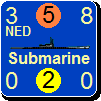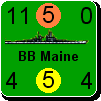composer99
Posts: 2923
Joined: 6/6/2005
From: Ottawa, Canada
Status: offline

|
USSR strategic bombing has come up in the context of making a claim against Bessarabia, but I would also like to bring up USSR strategic bombing in general.
Potential Targets
Germany: The closest and most prominent German-controlled target for USSR strategic bombing is Rumania, either the oil fields or the factory in Bucharest. Other targets, depending on the location of the front lines, include the red factory in Poland, the oil in Austria, factory cities in Germany, Austria & Czechoslovakia, and synthetic oil plants if these are placed in the centre or east of the country. German-controlled red factories in the USSR are also potential targets (although in this case the USSR no doubt will want to avoid destroying the factory).
Italy: I do not perceive there being much in the way of viable Italian-controlled targets for USSR strategic bombing. What does seem possible is either oil hexes in Italian-controlled Iraq or Persia (if Italy aligns or conquers either or both of these countries) or factory cities & synthetic oil in northern Italy if USSR bombers are in range (and either Italy remains in play by that time or the region is German-controlled).
Japan: Unless the Japanese take Vladivostok and other USSR cities in the Far East, the USSR has opportunities to strategically bomb Japanese factories in Manchuria and factories & synthetic oil plants in Japan. If they are on the map, the 17-range LND4 or 11-range extended range LND3 can reach every factory in Japan from Vladivostok.
Constraints
The USSR has a number of constraints which make a sustained strategic air campaign less feasible for the USSR than the other Allies, and perhaps even a long-term nuisance strategic air campaign (such as might be implemented by Japan vs. China or by the EuroAxis vs. CW) is also less feasible for the USSR.
Air Unit Availability
The USSR has quite a few air units with strategic air factors; however it has relatively few long-range, high-strat-factor units (1 on map & 1 in reserve at start of 1939 Global War campaign). Building air units specialized in strategic bombing is often contra-indicated by the strategic/tactical situation(s) the USSR finds itself in. The other availability constraint is not whether the USSR has air units on the map in range of targets, but whether it is has other, more important tasks for the air units on the map (e.g. ground strikes or defensive ground support). Building new long-range LND or replacing destroyed LND is often very expensive given shorter-term USSR production requirements during a German invasion.
Action Limits
The USSR often finds itself performing land actions, which are limited in air missions (3 to be precise); usually there are higher priority air missions (air rebases or ground strikes) to be undertaken given such tight constraints. This can be got round by performing combined, air, or supercombined actions, assuming the USSR can afford not to move many land units in the former two cases.
Territorial Limits
There are two sorts of territorial constraints to USSR strategic air bombing:
1- The USSR bombers are out of range of targets (whether due to intervening enemy-controlled hexes)
2- The USSR bombers, if used for the strategic bombing while in range, may find themselves overrun and destroyed if the strategic raid occurs during a turn with significant territorial loss by the USSR (summer 41/42, mainly)
Air Defences
The presence of Axis airpower to defend potential targets is often a strong constraint against USSR bombing, even if the USSR has the units & action limits available, since until the US-lent Black Widows are on the map USSR FTR are unlikely to have the range to accompany bombers to targets. On the other hand, forcing the Axis to commit FTR to defend strat bomb targets they might not otherwise have to defend is itself a goal of a USSR strategic air campaign.
Given the constraints involved, the USSR can probably only afford to have 1-2 bombers allocated to strategic air warfare, particularly if this entails keeping them away from principal theatres of land conflict. There are three areas where allocation of bombers makes most sense to me:
1- in Vladivostok. As noted above, a long-enough range bomber can reach almost every Japanese factory on the map. The USSR can bomb vulnerable hexes until the Japanese cover their factories & synthetic oil with FTR. Given a cost of 5-6 bp per USSR LND involved, this allocation is effective if the USSR does damage and/or forces commitment of defensive FTR equivalent to 7+ bp.
2- versus Axis-controlled Middle Eastern oil. There will likely be low to no FTR coverage, making for easy targets. It's probably not worth it unless an oil rule is in play.
3- versus Ploesti/Bucharest. If an oil rule is in play, the USSR should have a LND threatening the strategic air raid as long as it has hexes in range that are not liable to be conquered shortly. Long-range LND can reach almost all the rest of the Eastern Front as required, so LND based to threaten the oil bombing are not as far out of the way as LND targeting Japan or the Middle East.
_____________________________
~ Composer99
|
 Printable Version
Printable Version














 )
)  .
.  ) - just simply that's how I've always played it because it felt right and luckily it was. But that's an uncomfortable feeling, I like to understand the actual rules if possible
) - just simply that's how I've always played it because it felt right and luckily it was. But that's an uncomfortable feeling, I like to understand the actual rules if possible  .
.  .
.
 . Those that pretend they have are all liars, liars I tell you!!
. Those that pretend they have are all liars, liars I tell you!! 


 New Messages
New Messages No New Messages
No New Messages Hot Topic w/ New Messages
Hot Topic w/ New Messages Hot Topic w/o New Messages
Hot Topic w/o New Messages Locked w/ New Messages
Locked w/ New Messages Locked w/o New Messages
Locked w/o New Messages Post New Thread
Post New Thread